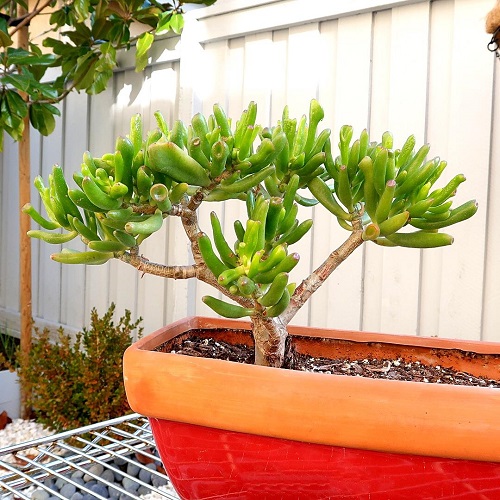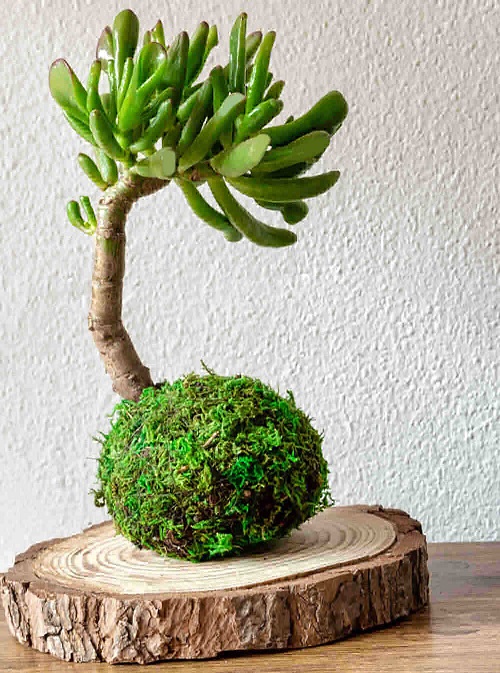Hobbit Jade Plant is a small specimen that can be a fantastic addition to cramped spaces! Here’re all the details on growing it.

Hobit Jade Plant is one the excellent choice for small areas of your home. It not just looks beautiful but also has minimum care needs. Here are the simple growing tips that will guide you to keep it thriving all year round.
Learn How to Grow Crassula Ovata here
Hobbit Jade Plant Information
The Hobbit Jade plant, scientifically known as Crassula ovata ‘Hobbit,’ is a succulent that belongs to the Crassulaceae family. It is a cultivar of the common Jade plant (Crassula ovata) and is believed to have originated from South Africa.
It is a compact, slow-growing succulent that features thick, fleshy, spoon-shaped leaves. The leaves have a unique tubular or finger-like shape with elongated tips that curl inward, giving them a distinctive hobbit-like appearance.
The leaves typically have a glossy green color, but with proper sunlight exposure, they may develop red or orange margins. The plant can reach a height of about 1 to 3 feet (30 to 90 cm) and has a shrubby, branching habit.
This succulent has a compact growth habit with thick, woody stems that become more pronounced as the plant matures. Over time, it can develop a gnarled and twisted appearance, adding to its whimsical charm.
The Hobbit Jade plant produces small, star-shaped flowers in clusters during the winter months. The flowers are usually white or pale pink in color and have a delicate appearance.
Here is How to Prune a Jade Plant Like an Expert
Propagating Hobbit Jade Plant
- Choose a mature and healthy Hobbit Jade plant from which you will take cuttings for propagation.
- Using clean and sharp pruning shears or a knife, take stem cuttings from the parent plant. Look for healthy stems that are at least 3-4 inches long.
- Place the stem cuttings in a dry and shaded spot for about 2-3 days or until the cut ends have formed a callus.
- Once the cuttings have callused, plant them in a well-draining mix suitable for succulents and cacti. Make a small hole in the soil with your finger or a pencil and gently insert the cut end of each stem cutting into the hole.
- Lightly mist the soil around the cuttings with water using a spray bottle. Avoid overwatering, as succulents are prone to rot if kept too wet. The soil should be slightly moist but not waterlogged.
- Place the potted cuttings in a location that receives bright, indirect light. Avoid exposing them to direct sunlight, as this can scorch the tender cuttings. A north or east-facing window is usually a suitable spot.
- Over the next few weeks, the cuttings will start developing roots.
You can also grow Hobbit Jade Plant by a leaf cutting:
Gently remove a whole leaf from the plant’s stem base. Allow the leaf to dry or form a callus for a few days. Now, plant the leaf in well-draining potting soil. Mist the leaf regularly to keep it from drying out. Soon, you’ll notice tiny roots starting to grow.
Propagate Any Plant Cutting Quickly Using this Trick
Best Pot Size for Growing Hobbit Jade Plant
As it is a small specimen, you can start the plant in a 4-5 inches pot. Depending on its growth over the years, plant in one size bigger pot than the old one, depending on its spread.
Here are Plant Pot Sizes from Inches to Gallon
Requirements for Growing Hobbit Jade Plant

Sunlight
Hobbit Jade plants thrive in bright, indirect sunlight. They can tolerate some direct morning (4-5 hours would be great!) or evening sunlight, but intense, hot midday sun may scorch their leaves.
Place your plant near a window with filtered light or in a location with bright, indirect light.
Soil
Use a well-draining soil mix formulated for succulents and cacti. A blend of regular potting soil with perlite or coarse sand works well to improve drainage. For best growth, use:
- 2 parts cactus/succulent potting mix
- 1 part perlite
- 1 part coarse sand
- Optional: ¼ part organic matter (composted bark or coconut coir)
Ensure the soil mix is well-blended before potting your Hobbit Jade plant. The resulting soil mix should be loose, well-draining, and allow excess water to flow out easily. Avoid heavy, water-retentive soils that can lead to root rot.
Learn some Great Tips to Rejuvenate Your Old Soil here
Watering
Hobbit Jade plants are succulents and have low water requirements. Allow the soil to dry out between waterings to prevent overwatering, which can cause root rot.
Here are the best ways to water plants
Water thoroughly but infrequently, ensuring excess water drains out completely. Typically, watering once every 7-10 days is the best. Reducing watering during winter dormancy is essential.
Temperature Range
Hobbit Jade plants prefer moderate temperatures ranging between 645-90°F (8-32°C). They can tolerate higher temperatures, but excessive heat may cause leaf discoloration or wilting.
Protect them from extremely cold drafts or frost, as they are sensitive to freezing temperatures.
Humidity
Hobbit Jade plants are adaptable and can tolerate normal household humidity levels. They don’t require high humidity but can benefit from moderate humidity.
In heated indoor environments, you can increase humidity by placing a tray of water near the plant. Do note that being a succulent, it doesn’t need too much humidity so use a using a room humidifier only when the air is excessively dry.
Here are 10 Ways To Increase Humidity For Houseplants That Work
Hobbit Jade Plant Care

Fertilizer
Hobbit Jade plants have relatively low fertilizer needs. Feed them with a balanced, water-soluble fertilizer formulated specifically for succulents and cacti.
Dilute the fertilizer to half the recommended strength and apply it during the active growing season (spring and summer) every 2-4 weeks.
Want to Make Organic Fertilizers from Kitchen Scraps? Click here
Discontinue fertilization during the winter months when the plant is in dormancy.
Pests and Diseases
Hobbit Jade plants are generally resistant to pests, but they can occasionally be affected by common succulent pests such as mealybugs, scale insects, and spider mites. Regularly inspect your plant for any signs of infestation, such as sticky residue, tiny webs, or cotton-like clusters.
If you notice pests, you can use an insecticidal soap or a horticultural oil spray specifically formulated for succulents to control the infestation.
Learn about Using Apple Cider Vinegar for Pests here
Hobbit Jade plants are relatively resistant to diseases, especially when provided with proper care. However, overwatering and poor air circulation can lead to problems such as root rot, fungal infections, or bacterial diseases.
To prevent these issues, ensure that the soil has excellent drainage and avoid overwatering. Allow the soil to dry out between waterings and avoid waterlogged conditions.
Providing good air circulation around the plant and avoiding overcrowding can also help prevent fungal diseases.


